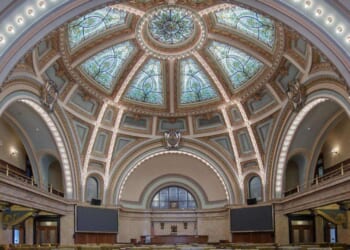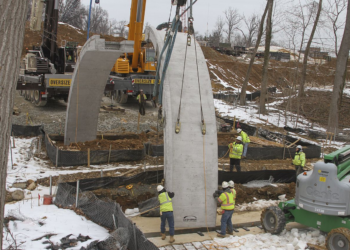Bolivia’s fuel pumps are running on empty, an almost unthinkable crisis for a country once known for its vast natural gas reserves. Long lines of trucks and cars stretch through city avenues, with drivers waiting hours or even days for gas or diesel. Bolivia’s state-run energy model has produced a fuel shortage.
How did a nation that once enjoyed a gas surplus run dry in less than two decades? The answer lies in Bastiat’s lesson of “what is seen and what is not seen.” The 2025 crisis showcases the consequences of long-term extreme government intervention and reveals why only a return to free-market principles can refill the country’s tank.
Bolivia’s Current Situation
Since 2023, Bolivians have endured recurring fuel shortages. Drivers across the country face endless queues sometimes stretching 15 blocks or more. Truckers report spending entire nights in line just to secure limited diesel rations. By March 2025, seven of Bolivia’s nine regional governors declared a state of emergency, demanding urgent action from the central government.
Initially, the socialist government of President Luis Arce downplayed the issue, blaming logistics, hoarding, or “speculation.” But reality could no longer be denied. Ministers eventually admitted that the country lacks fuel because it lacks dollars; Bolivia has become so dependent on imports that it now spends a staggering $56 million per week buying fuel abroad.
That’s more than double what it spent just five years ago: $1.5 billion in 2019 vs. $3.3 billion in 2024. Bolivia must now import 86% of the diesel and 54% of the gasoline. This dependence leaves the country vulnerable to foreign currency disruptions, and as the broader economy has declined, Bolivia’s reserves have dried up, making it harder to pay suppliers.
Meanwhile, subsidized prices at the pump are unsustainable. Bolivians pay about $0.53 per liter, less than a fourth of what Americans pay on average, and less than half of what neighbors like Peru or Brazil charge. These state-mandated low prices force the government to sell fuel below cost, draining public funds to cover the gap. Worse, cheap fuel creates an incentive for smuggling. Officials estimate that “reverse contraband” (fuel smuggled out of Bolivia to be resold abroad) costs Bolivia about $600 million annually.
In short, Bolivia loses dollars on both ends: overpaying for imports, then watching that fuel slip away.
State Control: The Root of the Problem
At the heart of the crisis lie politicized management, price-fixing, and short-term thinking. What citizens see are cheap fuel prices; what they don’t see are the long-term distortions, dwindling investment, mounting subsidies, and now, actual scarcity.
“There’s no rice, and we have sick people, there’s nothing. This government lies to us… If we don’t rise up, who’s going to help us?”
– from an interview by Red America TV
Prices set by decree scare off private initiative. No business wants to import or produce fuel only to sell it at a loss. Exploration and refining halted as a result. Between 2014 and 2023, petroleum production fell by 54%. Natural gas production dropped by 45%. Yet consumption kept growing, due to artificially low prices. A shortage was inevitable.
The government also relied heavily on past surpluses without reinvesting. Bolivia enjoyed a gas export boom in the early 2010s, but the government treated it like a bottomless piggy bank. Instead of reinvesting in exploration or infrastructure, much of the revenue went to subsidies and other political projects.
By 2023, gas exports had fallen from $6.6 billion to about $2 billion. The state model encouraged short-term consumption at the expense of long-term sustainability.
These shortages are not the result of global shocks; they are the predictable outcome of central planning. Responsible policy adjustments were postponed for political gain.
Before and After State Ownership
The past three decades tell a clear story: market-driven growth followed by state-driven stagnation.
In the 1990s, President Gonzalo Sánchez de Lozada partially privatized YPFB and welcomed foreign investment. The results were transformative. Major gas fields like San Alberte and Sábalo were discovered, and pipelines connected Bolivia to Brazil and Argentina. By the early 2000s, gas production had tripled. Exports boomed, becoming Bolivia’s main revenue source.
But in 2006, Bolivia took a U-turn. President Evo Morales nationalized the sector—not by expelling foreign companies outright, but by increasing state ownership through YPFB. The government collected over $50 billion in gas revenues, using them to fund social programs. Poverty fell, and Morales’s popularity surged, fueling the illusion that state ownership had delivered prosperity.
But that boom was built on momentum from earlier reforms and high global prices. By the late 2010s, the cracks were showing. Gas production declined sharply. By May 2023, output was down 45% from its 2014 peak. The government renegotiated export contracts to avoid penalties for non-delivery.
At home, Bolivia began importing fuel in bulk, and soon, even natural gas.
Private Fuels and Energy: The True Solution
To escape this crisis, Bolivia must abandon the statist approach and embrace a free market. That means ending fuel subsidies and price controls, welcoming private investment, enforcing property rights, and competition in the energy sector. There will be short-term pain, but the alternative is indefinite decline.
Economists, like Roberto Laserna, have warned against Bolivia’s “state-resource boom” mentality. Sustainable growth requires market-led diversification.
Bolivia must follow. Let private enterprise lead in a competitive environment, a rules-based energy sector. If it does, recovery will follow, and the pumps might be full again.







